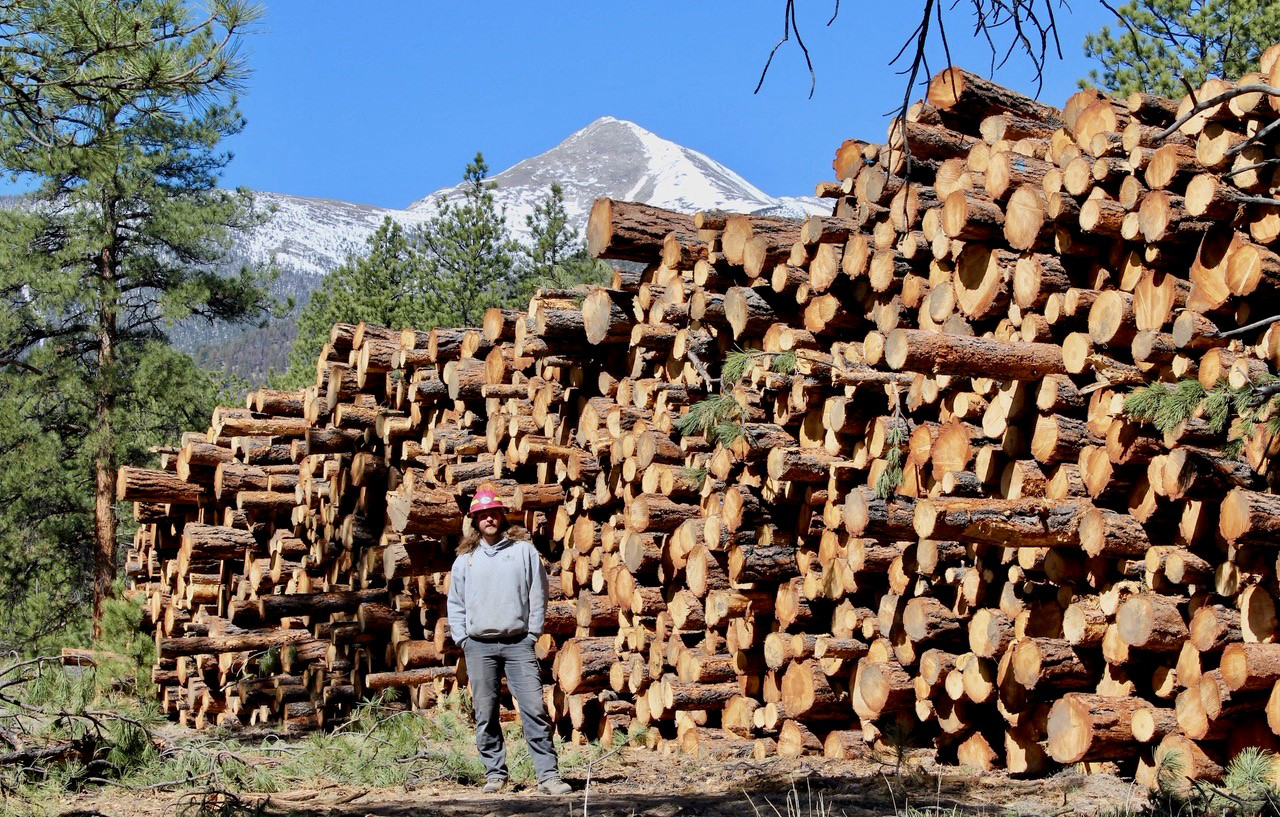Alma-based P&A Forestry is cutting trees as part of a new wildfire mitigation project underway on State and private land along Rodeo Road at the base of Mount Princeton, southwest of Buena Vista.
A press release from the Colorado State Forest Service indicates the work began in April on the Maxwell Park State Land Board property and continues on Frontier Ranch, a 591-acre resort property owned and operated by Young Life, a $470 million-a-year Christian nonprofit based in Colorado Springs.
The State Forest Service describes the project as a “110-acre fuel break … designed to protect the community from a fast-moving wildfire that could start in the Collegiate Peaks Wilderness, where forests have been decimated by beetle and budworm infestations … .”*
Colorado State Forest Service Forester Josh Kuehn said, “Without their (Young Life’s) participation, this project would not have been feasible.”
When asked about matching funds, Kuehn responded, “Young Life is providing no financial match for the fuel-break project,” but they are “allowing us to conduct educational tours of the project to help inform the public.”
Kuehn added, “This project is funded partially by a CSFS State Fire Assistance grant – which is U.S. Forest Service grant money that CSFS competes for with 22 other Western states – and (by) Chaffee Common Ground.”
Chaffee Common Ground is the county grant program established through a ballot initiative promoted by participants in the Chaffee County Envision community planning initiative that began in 2016.
The ballot initiative, approved by voters in 2018, created a new county sales tax that generates approximately $1.2 million per year to be allocated to:
- “Strengthening forest health” (25%).
- “Conserving and supporting (privately-owned) working lands” (25%).
- “Managing recreation growth impacts” (5%).
- “Discretionary fund to be allocated among the three categories” (45%).
Kuehn said, “The (Envision) Forest Health Council and CSFS seek to work with all landowners where optimal treatment locations can protect critical assets, evacuation routes and homes in this case. … We were lucky to gather enough grant funds for this to come as no expense to the landowner.”
Other participants include homeowners in Pine Grove Estates, Whispering Pines and The Journey’s End, where Chaffee County-based Colorado Firecamp and the Southwest Conservation Corps are thinning trees on residential lots.
“Our work focuses on treating from the front door to the forest,” said Kent Maxwell, fire and forestry coordinator with Chaffee-based Colorado Firecamp. “We often start at the home ignition zone, extending out with roadside thinning that connects with larger-scale treatments on public lands.”
Kuehn said selectively removing trees on these properties will create a 110-acre fuel break designed to reduce the intensity of a potential canopy fire. “Canopy fires spread in quickly from one treetop to the next. They are the most intense type of wildfire and often the most difficult to contain, especially in high winds.”
The fuel break provides a chance for a fire to “move to the ground” and slow down with the help of first responders, he added.
Kuehn’s description of the benefits of the fuel break aligns with State Forest Service policies and practices, influenced for decades by U.S. Forest Service policy and funding opportunities – funding opportunities that are experiencing record increases thanks to the federal Infrastructure Investment and Jobs Act.
Dr. Timothy Ingalsbee, a former wildland firefighter for the U.S. Forest Service and National Park Service, wrote “A Reporter’s Guide to Wildland Fire” to help counter the “hype” surrounding wildfire, which he believes “is a harmful influence on forest policy in the U.S.”
Canopy fire, or crown fire, Ingalsbee writes, “is the most popular image shown on television newscasts, yet it is the rarest type of fire. Crown fires are normally fast-spreading and high-intensity fires. … They are also the fires that are near impossible to humanly contain and control.”
Since 1983, National Interagency Fire Center records show that an average of 70,000 wildfires have burned each year. According to the U.S. Forest Service, 98% of these fires are controlled by firefighters before they grow larger than 100 acres and become destructive to communities.
Yet a study led by Philip Higuera shows that the destructiveness of this 2% of uncontrolled fires increased by 246% over the past decade.
In spite of firefighters consistently successfully containing 98% of wildfires, the science leads Jack Cohen to concur with Ingalsbee: “There is no management trend that indicates that we’re going to be able to control all wildfire.”
Cohen recently retired from his position as a research physical scientist at the U.S. Forest Service Fire Sciences Research Lab in Missoula, Montana.
Based on his 47 years of studying wildfire, including firsthand experience on fire fronts, he concludes, “While extreme wildfires will evade control and inevitably spread to communities, WU (wildland-urban) fire disasters are not inevitable. We can effectively prevent WU fire disasters by reducing home ignitability … without necessarily controlling wildfires or altering vegetation.”
Tania Schoennagel, a landscape ecologist with the University of Colorado, has reached the same conclusion: “There’s no way we can remove enough trees … to have a significant impact on wildfire.”
She cites the 2012 High Park Fire, which destroyed 259 homes and killed one person in residential areas near Fort Collins. Forest-thinning projects were conducted in the area for more than a decade, but the fire encountered almost none of the thinned areas as it burned through 87,000 acres.
Nonetheless, Cohen observes, “Federal, state and local fire agencies continue to focus on wildfire suppression and pre-fire fuel breaks … and forest fuel treatments as the principal approach for protecting communities.”
By leveraging Common Ground tax monies, the Envision Forest Health Council has secured $23 million in funding from these agencies, and most of that money by far is allocated to fuel breaks and forest thinning.
A small portion of that money has been used to fund the Chaffee Chips program, which begins to address Cohen and Schoennagel’s findings by encouraging Chaffee County residents to clear brush and trees within the home ignition zone.
Through Chaffee Chips, the resulting slash is either mulched on site by the State Forest Service or hauled away by firefighters with the Chaffee County Fire Protection District.
The free service has helped homeowners create defensible space to reduce the risk of losing their homes and provide safer working conditions for firefighters in the event of a wildfire.
But Chaffee Chips doesn’t address the most effective strategies for protecting lives and property from wildfire, according to Alexandra Syphard, senior research ecologist with the Conservation Biology Institute.
Her research demonstrates that the most effective strategies “by far” are to address the “structural characteristics of the house associated with ember penetration” – vent screens, enclosed eaves, multi-pane windows and defensible space up to 5 feet from the home.
The next most effective strategy, Syphard said, is thinning vegetation out to about 40-60 feet. “Anything beyond 60-70 feet was not significantly beneficial when it comes to structure loss.”
The State Forest Service indicates the Rodeo Road fuel-break work should be completed in July. Work on individual lots will continue throughout the year, providing opportunities for Colorado Firecamp students to hone their sawyer skills as part of wildland firefighting classes.
The State Forest Service press release notes that the Rodeo Road project “is among several large fuel breaks underway or completed since the (Chaffee County) community wildfire plan was updated in 2020.
“Additional projects are located along the Arkansas River north of Buena Vista, in the North Cottonwood Creek drainage northwest of Buena Vista, on Coyote Valley Road west of Nathrop, on the Methodist Front south of Salida and Poncha Springs, and on Poncha Pass. More than 5,000 acres have been thinned since 2020.”
For more information about local wildfire mitigation projects, the press release encourages readers to visit the Envision Chaffee County website and click on “Ensuring Healthy Landscapes.”
The press release also states, “Envision is a nonprofit convened by the Chaffee Board of County Commissioners,” but this statement is not supported by available documentation.†
* University of Colorado researchers studying the West Fork Complex fire “found that higher levels of spruce beetle infestation did not lead to more ecologically severe fires.” Additionally, a 2016 study by Meigs, et al., concludes, “In contrast to common assumptions … we find that insects generally reduce the severity of subsequent wildfires.”
† Envision Chaffee County operates as a nonprofit under the fiscal sponsorship of the Chaffee County Community Foundation, and Colorado Secretary of State records indicate the articles of incorporation for Envision were filed by Richard (Rick) Hum, one of the original Envision board members. Hum is still listed as the “registered agent” of Envision even though he is no longer listed as a board member and has reportedly moved to New Hampshire. His most recent filing with the Secretary of State has changed the address associated with Envision to Executive Director Cindy Williams’ residential property (according to the Chaffee County Assessor’s database). Neither Hum nor Williams have served Chaffee County in a staff or elected official capacity.








